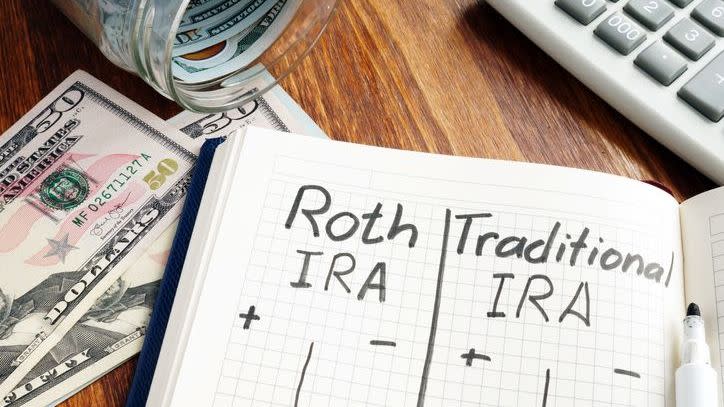Taxes are a valid concern if you want to roll over $720,000 from your retirement fund into a Roth IRA. While you won’t pay any taxes if the assets you’re rolling over are held in another Roth account, there’s typically no way to completely avoid paying taxes when rolling pre-tax money into a Roth IRA. However, with a few strategic moves, you can potentially limit today’s tax pain while still reaping the rewards of tomorrow’s tax-free benefits. To determine if a Roth rollover aligns with your overall savings and tax strategy, consider running the numbers with a financial advisor who’s attuned to your financial situation and retirement vision.
Roth Rollover Rules
A Roth IRA is a retirement account that allows people to contribute after-tax dollars. Unlike a traditional IRA, you don’t get a tax break on Roth contributions. However, qualified Roth withdrawals in retirement can be made tax-free. This differs from traditional IRAs, whose contributions are often tax-deductible but withdrawals are taxed as ordinary income.
In general, you can roll over funds from another retirement account such as a traditional IRA or 401(k) into a Roth IRA. This is called a Roth conversion or Roth rollover. When you convert funds, you owe income taxes on the amount that’s rolled over for that year. So if you roll over $50,000 from a traditional IRA to a Roth IRA, the $50,000 is added to your taxable income for the year.
It’s important to understand that Roth rollovers are not the same as Roth contributions. Higher-income taxpayers may not qualify to make direct Roth contributions. However, there are no income limits on doing Roth conversions from other accounts.
You can roll over funds from 401(k)s, 403(b)s, 457 plans, traditional IRAs, SEP IRAs and Simple IRAs. To start the process, contact the institution that holds the account you want to roll over and convert. They can help facilitate the transfer. You typically have 60 days to complete the conversion, otherwise, the IRS will treat the transfer as a distribution and you could be hit with a 10% early withdrawal penalty. But if you need additional help determining how much to roll over and convert, consider speaking with a financial advisor.
Why Roth Rollovers Matter
There are a few key reasons why an individual might choose to do a Roth conversion:
Tax-free growth: Money that’s converted into a Roth IRA grows tax-free. This differs from traditional IRAs whose investment earnings are tax-deferred but eventually get taxed when they’re withdrawn. Roth withdrawals will be 100% tax-free, provided you satisfy the five-year rule and are 59.5 years old.
Avoid RMDs: Traditional IRAs are subject to required minimum distributions (RMDs) – mandatory withdrawals that start at age 73. For those who don’t need these distributions, RMDs can create excess taxable income. However, Roth conversions eliminate future RMDs since Roth accounts are not subject to these rules.
Tax savings: Paying conversion taxes now can make sense if you expect to be in a higher tax bracket in retirement. Roth conversions lock in today’s rates. They also reduce future RMD amounts that could push you into a higher bracket.
Inheritance planning: Heirs who inherit Roth IRAs can potentially stretch out tax-free distributions over their life expectancy, depending on their relation to the person who died. However, some beneficiaries will be required to empty the account within 10 years.
As you can see, there are some good reasons to convert an IRA or 401(k) into a Roth IRA, but a financial advisor can help you explore how such a transaction may impact your finances and tax liability.
Roth Rollover Strategies
When doing a Roth conversion, the main drawback is the tax obligation. There are some strategic moves to potentially reduce taxes, though:
Partial conversions: One method is to do partial Roth conversions over multiple years instead of converting your entire balance at once. The idea is to convert just enough each year to “fill up” your current bracket with income while also avoiding a higher bracket.
Low-tax years: In low-income years it may make sense to convert larger sums. This could be early in retirement before RMDs or Social Security begins. Again, the goal is to add just enough extra income to fill up your current tax bracket without pushing you into the next tax bracket.
Use non-retirement assets: Many experts suggest paying conversion taxes with non-retirement funds instead of IRA assets. This allows your entire IRA balance to transfer to the Roth account and keep growing tax-free.
If you need help determining which strategy is best for you, consider using this free matching tool to connect with a fiduciary financial advisor.
Rollover Strategies in Action
As an example, let’s consider a single filing taxpayer who wants to roll over $720,000 from an old 401(k) to a Roth IRA. Here are a few scenarios to think about:
Lump Sum Conversion
Converting the entire $720,000 would potentially generate a tax bill of nearly $220,000 at today’s top marginal rate of 37% (assuming you take the standard deduction of $14,600). That whole sum has to be paid for the year in which the conversion is completed.
Partial Conversions Spread Over 10 Years
Completing a series of conversions each year for 10 years controls tax bracket jumps and spreads the tax hit over a decade. A $72,000 annual conversion would put you in the 22% bracket if you have little or no additional income. That translates to a tax bill of approximately $7,700 per year or $77,000 over 10 years – less than half of what you’d pay on a lump sum conversion. Keep in mind that your balance will potentially continue to grow during these 10 years, requiring additional conversions and more taxes to pay.
Low-Income Year
By maximizing conversions during years in which your income dips, you can take advantage of being in a lower tax bracket. For example, say you earn $60,000 in taxable income in a typical year, placing you in the 22% bracket and resulting in a tax liability of approximately $5,200 after taking the standard deduction. If you also convert $72,000, you'll move up into the 24% bracket with $132,000 in total taxable income. You’d see your tax liability climb to around $21,000. Do this two years in a row and your combined tax bill will be approximately $42,000.
But say you will only receive $30,000 one year because you are taking a six-month sabbatical. You could skip conversions in the previous year and convert two years' worth, or $144,000, in the sabbatical year. That year, you'll have an income of $174,000, including $144,000 in conversions and $30,000 from salary. This would put you in the 24% bracket and generate a tax bill of approximately $31,000. Add the $5,200 tax bill from the previous year and your two-year tax bill could end up being around $36,200. A financial advisor can help you assess whether this strategy may be an option for you.
Non-Retirement Assets
Using non-IRA funds to pay your tax bill on a conversion allows the full amount of the rollover to go into the Roth account. If you use taxable funds rather than IRA funds to pay all taxes due on a lump sum conversion of $720,000, that's $227,000 more you'll have growing tax-free in your Roth.
Bottom Line
Roth rollovers can reduce future taxes and eliminate RMDs in retirement, at the cost of having to pay more in taxes today. Strategic partial conversions completed over several years, conversions timed with low-income years can potentially limit the tax pain, as well as using non-retirement assets to pay conversion taxes. Consult with financial and tax professionals to map out a tax-savvy approach.
Retirement Planning Tips
With a major retirement move like a Roth conversion, it helps to sit down with a financial advisor who can analyze your full financial picture. Finding a financial advisor doesn't have to be hard. SmartAsset's free tool matches you with up to three vetted financial advisors who serve your area, and you can have a free introductory call with your advisor matches to decide which one you feel is right for you. If you're ready to find an advisor who can help you achieve your financial goals, get started now.
It’s important to have a sense of the progress you’re making as you plan and save for retirement. SmartAsset’s free retirement calculator can help you estimate how much money you may need to save to retire and whether you’re on track to hit that target.
Photo credit: ©iStock.com/izusek, ©iStock.com/designer491, ©iStock.com/Chainarong Prasertthai
The post I Want to Roll Over $720k to a Roth IRA. How Do I Avoid Paying Taxes? appeared first on SmartReads by SmartAsset.


